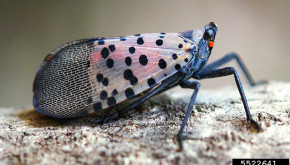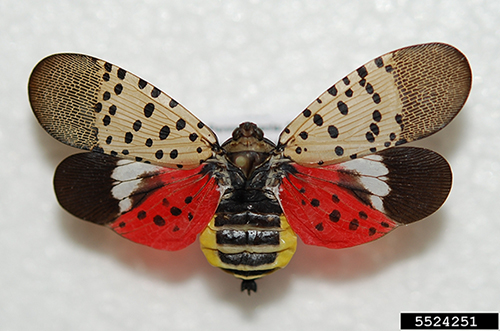
Spotted lanternfly is Pennsylvania’s newest threat to plants and trees. It is important that citizens in Pennsylvania and surrounding states are aware and vigilant as we work together to control its spread.
Spotted lanternfly (SLF), an invasive planthopper, is an emerging pest in Pennsylvania. After its first appearance in Berks County in 2014, its spread has been far and fast ranging. Forest landowners, the agricultural community, forest industry, and government agencies are working hard to reduce the threat and slow the spread of this pest which feeds on a wide range of fruit, ornamental, and woody trees, with tree-of-heaven (Ailanthus) being one of the preferred hosts. SLF can be spread long distances by people who move infested material or items containing egg masses.
The Pennsylvania Department of Agriculture (PDA) recently released a series of Best Management Practices (BMPs) for landowners, foresters, loggers, and processors in the forest products industry to assist them in their vigilance to find and address SLF. Quarantine areas are expanding and awareness is necessary for attempts to control this insect to be successful.
Current Quarantine Information
Currently a quarantine is in place to stop the movement of this pest to new areas and to slow its spread within the quarantine. The quarantine affects a variety of plant, wood, and stone products. The quarantine may be expanded to new areas as further detections of the Spotted Lanternfly are made and confirmed. As of March 27, 2018, these 13 Pennsylvania counties are under quarantine: Berks, Bucks, Carbon, Chester, Delaware, Lancaster, Lebanon, Lehigh, Monroe, Montgomery, Northampton, Philadelphia, Schuylkill. With the spring hatch in April and May, the range is expected to grow rapidly. For up-to-date information on the insect, the quarantine, restrictions within the quarantined counties, what you can do to prevent its spread, and more, visit: www.agriculture.pa.gov/spottedlanternfly
Penn State Extension is also holding information sessions and seminars on SLF throughout central and eastern Pennsylvania. On the website you can find how-to videos on removing egg masses, updates on control options, lifecycle information, and much more. Visit extension.psu.edu for more information.
PDA and Penn State Extension, along with agricultural and forest industries and federal agencies, are working hand in hand to get the word out, educate, and support landowners being impacted by the pest, and are working to halt its spread. Stay tuned in and help get the word out.


